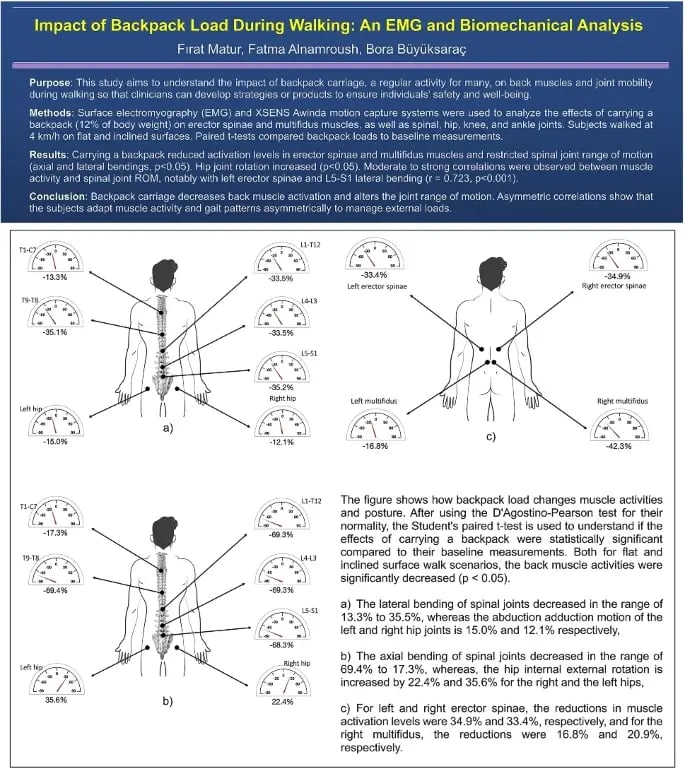Carrying a heavy backpack does more than just make us lean forward: it changes how our entire body moves. At Bahçeşehir University, Assistant Professor Bora Büyüksaraç used Xsens Awinda and Xsens Analyze to uncover the hidden biomechanical trade-offs between the spine and hips, revealing how the body stabilizes under load.
Challenge: Bora needed a way to measure the precise movement strategy the body uses to compensate for a heavy backpack, especially the hidden trade-offs between the spine and hips.
Solution: Xsens Awinda and Xsens Analyze provided the high-fidelity kinematic data needed to uncover the body's "stiff spine, mobile hips" strategy. The system made the invisible trade-off between spinal stability and hip mobility visible and quantifiable.
Key takeaways:
- Revealing the trunk-stiffening strategy: The study showed that carrying a backpack causes the body to instinctively brace the core, significantly reducing the range of motion in the lumbar spine to create a stable platform for the load.
- Quantifying the kinetic chain trade-off: Xsens data was crucial in identifying the "hidden" compensation. To make up for the rigid spine, the hips increased their rotational movement, demonstrating a clear biomechanical trade-off.
- Enabling data-driven ergonomic design: The precise joint-level data from Xsens provides a quantitative framework for future studies, allowing researchers to test backpack designs that support loads without compromising healthy, natural movement patterns
Carrying a heavy backpack clearly changes our posture, especially over long periods of time. But beyond the visible forward lean, what is really happening to our joints and movement patterns? Bora Büyüksaraç, Assistant Professor at Bahçeşehir University, wanted to look deeper than just posture. In his research "Impact of backpack load during walking: an EMG and biomechanical analysis", he set out to quantify the precise biomechanical trade-offs the human body makes when walking with a loaded backpack, analyzing the complex interplay between spinal kinematics, muscle activation, and joint range of motion in a cohort of young adult participants.

Source
Pinpointing the issue
We all instinctively feel that a heavy backpack changes how we walk, but the body is a master of compensation. From his own observations and background in biomechanics, Bora knew the real story was in the data. The key was to uncover the body's hidden strategy for managing the load. “Given my background in biomedical engineering, I wanted to collect objective data on how the body redistributes movement when carrying a load,” explains Bora. “The question wasn't just if our movement changes, but how. Which joints become restricted, and which have to compensate to maintain our gait?”
For the experiment, Bora and the research team recruited a cohort of 20 young adults. The experimental protocol took place in the university's biomechanics lab, where each participant walked on an instrumented treadmill under four distinct conditions: with and without a loaded backpack, on both a flat and a five-degree inclined surface. To ensure consistent conditions, each backpack was weighted to 12% of the participant’s individual body mass.
Electromyography and Xsens
To answer this kinematic question, the team turned to Xsens, provided by Sense4Motion. The Xsens Awinda system uses IMU (inertial measurement unit) sensors, which makes it ideal for treadmill studies where camera-based systems can be restrictive. The sensors accurately track the orientation and velocity of each body segment, providing a detailed, whole-body picture of the subjects' movements.
The motion capture data was the key. When assessed in the Xsens Analyze software, it clearly revealed the body’s strategy: subjects significantly restricted their spinal motion, sacrificing up to 69% of their normal axial rotation to create a rigid, stable platform for the load. This clear, quantifiable trade-off between spinal stability and hip mobility was the central finding of the investigation.
To get a more complete picture, the team also measured muscle activity using electromyography (EMG). The results provided a surprising confirmation of the kinematic findings. With the spine braced and rigid, the core back muscles actually showed a decrease in activation. The body was relying on the stiff posture revealed by Xsens, not extra muscle force, to manage the load.
“The data we received from the Xsens Analyze software was incredibly consistent and reliable,” says Bora. “We could clearly see the reduction in spinal ROM and the corresponding increase in hip rotation, giving us a high degree of confidence in our analysis.”
Planning for the future
Bora and the team at Bahçeşehir University successfully identified the "stiff spine, mobile hips" strategy that healthy young adults use to carry backpacks. Their research also showed that this compensatory pattern occurs on both flat and inclined surfaces, highlighting a consistent response to load. But how can this knowledge be used to improve well-being?
The team has already begun work on a new study to test how different backpack designs and strap lengths affect this biomechanical trade-off. Bora aims to use the data to identify the least restrictive type of backpack, which could help advise manufacturers on more ergonomically sound designs.“We have used Xsens for a long time at Bahçeşehir University, and will continue to do so,” Bora concludes. “It provides the detailed kinematic data we need to carry out insightful and accurate research.
Learn more about Xsens motion capture for biomechanical research.